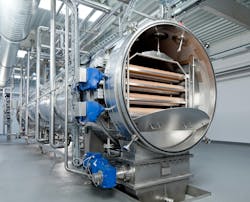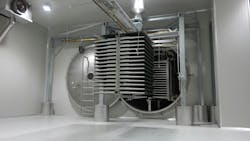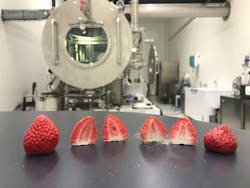
Drying processes are used in a variety of industries to transform moisture-containing products, liquids or pasty media with a total solid ratio into a dried or powdered state. Usually, the preliminary and intermediate products are generated by nature as fruits or vegetables or by extraction, fermentation, or polymerization, then concentrated and dried using diverse methods. In most cases, drying means removing water by converting it into its vapor state, but drying can also refer to extracting other carrier liquids, such as solvents.
The ideal drying method is determined by the characteristics of the intermediate and final products as well as the achievable throughputs within a given time. Important factors include the material’s thermal sensitivity, dosage form, and viscosity.
(Hot) air drying
Air drying is a widely used procedure in which products are dried in controlled drying cabinets or rooms at room temperature over a long period of time. To speed up the process, hot air can be used to accelerate the evaporation of the carrier liquid. This procedure is often used to dry plants or products of vegetable or natural origin and is also used in the tobacco industry.
The main disadvantages of air drying are the long drying time, the large amount of space required, mainly for drying rooms, and the energy input required when using hot air. Furthermore, degradation and oxidation might occur in the product, which can negatively impact product quality.
Vacuum drying
Vacuum drying is widely used, especially in the food industry, to produce powders such as those used for instant soups, malt, or chocolate drinks. Vacuum drying can also be used to increase the durability of miscellaneous fruits and vegetables or to gently dry fruit or vegetable juice concentrates to make them durable and storable and to reduce the transport volume.
During the drying process, the product to be dried is placed under vacuum in a chamber, and the air is removed from the chamber to a certain vacuum level, typically 10 to 20 mbar. This vacuum reduces the evaporation temperature of most liquids. Physically, this can be explained by the fact that, at atmospheric pressure, the air pressure is usually greater than the vapor pressure within the liquid and so the liquid cannot evaporate. Under vacuum, the air pressure becomes lower than the vapor pressure of the liquid, allowing the liquid to evaporate without additional energy input. Water will evaporate at 17.5 °C (63.5 °F) at a vacuum level of 20 mbar without adding additional heat energy. This has the great advantage of allowing the product to be dried much more gently without the input of heat, which significantly improves product quality and reduces drying times.
Vacuum drying can be conducted in either batch or continuous processes. For batch processes, the product is usually filled into trays and dried for a certain period with a specific temperature and pressure profile. In continuous processes, the product is usually dosed onto belts in liquid form and then continuously dried and discharged from the vacuum tube.
Freeze drying
Freeze drying is a special form of vacuum drying, though the principle of operation is very similar. In freeze drying, the vacuum level in the drying chamber is further reduced to 1 mbar or less. At this pressure, water will undergo sublimation at -20 °C (-4 °F), transitioning directly from a solid state (i.e. ice) to a gaseous state. The product is deep-frozen before drying so that the water contained is available as ice crystals. During the drying process, the water evaporates from the product without any additional input of energy.
This drying method is even more gentle than pure vacuum drying and is particularly suitable for high-quality and high-priced products that require the cell or matrix structure to be retained after drying. Typical freeze-dried products include strawberries and other fruits, which after drying are difficult to distinguish visually from freshly harvested products. Freeze drying is also used to produce soluble coffee and is increasingly used in the pharmaceutical industry.
Freeze drying can also be conducted as a batch or continuous process, depending on the capacity and the product. For example, DEVEX liquid freeze drying (native drying) is characterized by the fact that liquid products are conveyed from an atmospheric pressure chamber into the freeze dryer, which is under deep vacuum, so freezing and sublimation occur continuously.
Dryer selection
When selecting a dryer, it is important to consider several factors beyond price such as quality, service, and operational ease and flexibility. For example, DEVEX batch or continuous belt dryers are designed and manufactured in Germany and the scope of delivery includes extensive project planning through to commissioning and training of the customers’ employees on site. Also, DEVEX dryers are highly flexible thanks to external condensers for the water vapors and can therefore be used for a wide variety of products. Furthermore, all DEVEX freeze dryers are characterized by dual operation, so that vacuum and freeze drying can be implemented in the same system, simply by switching over in the control system. The control of the DEVEX vacuum and freeze drying plants can individually be adjusted via various process parameters and the product temperature is constantly measured so that set limit values are not exceeded. And finally, cleaning of the continuous vacuum and freeze dryers is fully automatic.
About the Author

Nick Slater
Nick Slater is business development manager for DEVEX Verfahrenstechnik GmbH. DEVEX is headquartered in Warendorf, Germany and is a global provider of process engineering solutions specializing in extraction, evaporation and drying in the food, pharmaceutical and releated industries. DEVEX batch or continuous belt dryers are designed and manufactured in Germany and the scope of delivery includes extensive project planning through to commissioning and training of the customers’ employees on site.


